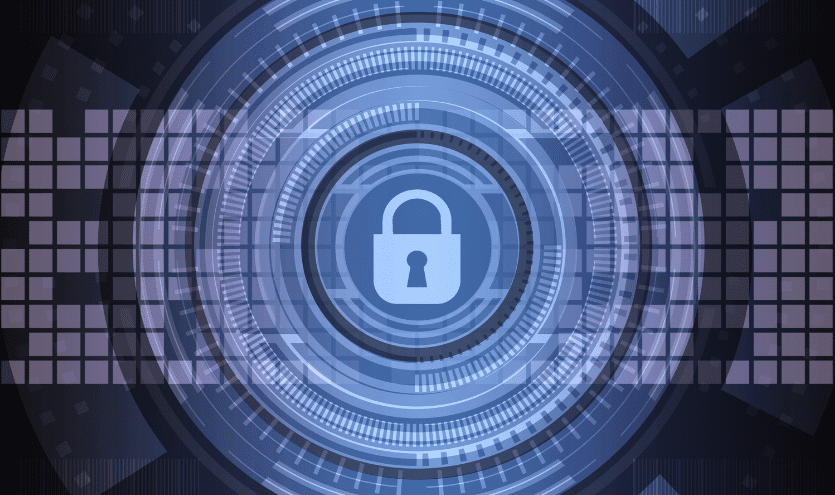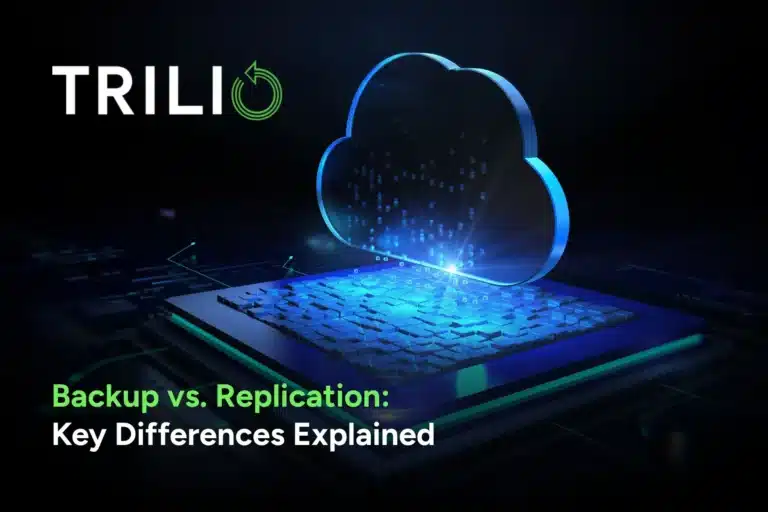By Trilio Content Team | September 29, 2022
Living in a world where unexpected calamities can occur at any given moment businesses are confronted with the task of protecting their operations and ensuring the safety of their data. Trilio presents this resource that explores the domain of disaster recovery. It guides you through the complexities of preparing for and recovering from disasters providing insights to help minimize the impact of crises. Whether you are an IT professional or a business owner this resource serves as your companion, in fortifying your organization’s resilience against circumstances putting an end to worrisome recovery scenarios once and, for all.
Getting a Grip on the Landscape of Disaster Recovery
A thorough investigation into the topic of disaster recovery involves classifying disasters as either natural or man-made and examining the difficulties associated with each category.
Various Types of Disasters
Natural disasters come in all shapes and sizes making them incredibly unpredictable. Earthquakes can bring cities crashing down within seconds while hurricanes and floods can submerge them underwater. Wildfires on the other hand can spread like wildfire across areas devouring everything in their path. Each disaster presents its set of challenges when it comes to planning for recovery.
The flip side to disasters is man-made ones which are often the result of human mistakes or malicious intent. Cyberattacks have the power to cripple infrastructure and systems resulting in data breaches and loss. System failures and operational errors can also lead to outages that require strategies for recovery.
The Price Tag of Downtime
To truly grasp why effective disaster recovery is so crucial one must understand the consequences associated with downtime. Every minute that systems are down means lost revenue and productivity go down the drain too. Not only that, a tarnished reputation can have long-lasting effects by eroding trust and customer loyalty over time. The longer it takes to recover from a disaster the heavier the financial burden becomes.
Legal Obligations and Compliance Considerations
In this age where data protection regulations like GDPR and HIPAA exist, organizations must adhere to compliance requirements without fail. Failing to comply with these regulations could result in penalties as well, as hefty financial repercussions.
Ensuring data compliance and integrity is crucial, in business practices and disaster recovery plays a role in achieving this.
Traditional Methods vs Modern Approaches to Disaster Recovery
Let’s explore the history of disaster recovery methods comparing the conventional approaches, with the innovative cloud-based solutions that are revolutionizing how we recover from disasters.
Traditional Approaches
In the past disaster recovery relied on tape backups and storing them offsite. While these methods had their uses they came with limitations. Tape backups were slow and offsite storage often meant that recovering data could take days or even weeks. In today’s paced world these traditional methods are inadequate for meeting the demands of modern data recovery.
Modern Solutions
As technology has progressed so have disaster recovery solutions to keep up with the age. One of the advancements is cloud-based disaster recovery, which allows real-time data replication and recovery from anywhere with an internet connection. This shift has greatly reduced both recovery times and data loss.
The Evolution of Disaster Recovery
Virtualization and automation have completely transformed how we approach disaster recovery today. Virtual machines can be quickly deployed to replace failed servers while automation tools can coordinate recovery processes seamlessly. Additionally, Disaster Recovery as a Service (DRaaS) has become increasingly popular as it provides cost-effective solutions, for businesses of all sizes.
Key Elements of an Efficient Plan for Recovering from Disasters
A comprehensive disaster recovery plan includes elements like evaluating risks backing up data replicating information and conducting regular tests, for disaster recovery.
Evaluating Risks
The cornerstone of any disaster recovery plan is conducting an evaluation of potential risks and vulnerabilities within an organization. For instance, when dealing with disasters it involves assessing locations and the associated risks. In the case of man-made disasters like cyberattacks, the focus would be on network security and controlling access.
Equally important are strategies to mitigate and prevent risks. These can include disaster preparedness measures, insurance coverage, and options for transferring risk to minimize the impact of disasters.
Safeguarding Data through Backups and Replication
Data serves as the lifeblood for organizations making backup and replication strategies crucial. This entails automated backups and real-time replication of data. Ensuring data consistency and integrity is paramount often achieved through technologies such as snapshots and deduplication.
Testing Disaster Recovery Plans
The old saying “practice makes perfect,” holds true in disaster recovery planning as well. Regular testing and simulations are vital to ensure that recovery plans go beyond exercises and become practical functional strategies instead. These tests help identify weaknesses while offering opportunities to fine-tune recovery plans based on real-world scenarios.
Trilios Innovative Approach to Disaster Recovery
Introducing the features and capabilities of Trilio, in disaster recovery solutions.
Introducing Trilio
Trilio is leading the way in disaster recovery solutions. Trilio offers a range of products and services that guarantee data resilience, seamless recovery, and uninterrupted business operations. Trilio’s solutions are versatile and cater to the needs of organizations across industries.
Trilio’s Distinctive Features
Trilio stands out from the rest with its set of features that prioritize data resilience in disaster recovery. These exceptional aspects make Trilio an invaluable partner when it comes to safeguarding data.
-
- Recovery, at Specific Points in Time: Trilio offers a feature that enables organizations to recover their data and systems at desired moments in time. This capability allows for the restoration of data as it existed at any chosen point offering precision in recovery options. Whether it’s rectifying data errors, addressing security breaches, or handling data corruption this feature empowers organizations with control over their recovery timeline.
- Application-Focused Protection: Trilio goes beyond data recovery by placing an emphasis on protecting applications at the core level. This means not only safeguarding the data itself but also ensuring that the entire application environment is seamlessly restored. By taking this approach Trilio minimizes downtime and guarantees that applications are fully operational without disruption.
- Backup and Replication: Trilio’s innovative solution provides capabilities for backing up and replicating data. It optimizes both the transfer and storage of data ensuring backups while keeping the process streamlined. This efficiency is crucial for maintaining data integrity and reducing recovery times.
- Adaptability and Customization: Trilio’s solutions are designed to adapt to the requirements of organizations. Whether you’re running a business or managing an enterprise, Trilio provides scalability and customization options to ensure that your disaster recovery plan perfectly matches your specific needs.
By incorporating these capabilities Trilio’s unique approach to disaster recovery not only ensures the security of your data but also empowers organizations to bounce back quickly and effectively even in the event of unexpected catastrophes. This makes Trilio an invaluable partner for businesses, in search of a future-oriented disaster recovery solution.
Strategies for Disaster Recovery
In disaster recovery, it is crucial to follow the methods that focus on continuous monitoring training employees raising awareness, and promoting collaborative planning among all involved parties.
Continuous Monitoring and Timely Alerts
To ensure disaster recovery it is crucial to have a system in place for continuous monitoring. By using real-time monitoring systems issues can be detected as soon as they arise enabling immediate action. Automated alerts are also essential in reducing response times allowing potential problems to be addressed promptly and expediting the recovery process.
Training and Awareness for Employees
Human error often plays a role in causing disasters. Therefore it is vital to prioritize employee training and awareness efforts. This involves educating staff about disaster recovery plans ensuring they fully comprehend their roles and conducting drills to assess their knowledge and preparedness levels. Building a culture of preparedness is just as important as the technological aspects involved.
Collaborative Planning
An executed disaster recovery plan relies on collaboration, among all stakeholders involved in the process. IT teams, management, legal departments, and third-party service providers should all actively participate in the planning phase. This inclusive approach fosters a culture of preparedness. Guarantees that everyone is aligned when faced with unforeseen circumstances.
Looking Ahead to the Future of Disaster Recovery
The future of disaster recovery involves delving into emerging trends such, as intelligence, machine learning, edge computing, the Internet of Things (IoT), and blockchain. These technologies play roles in ensuring data integrity and security.
The Impact of Artificial Intelligence and Machine Learning
The realm of disaster recovery is on the brink of transformation thanks to artificial intelligence (AI) and machine learning (ML). By utilizing analytics driven by AI we can proactively anticipate disasters and implement automated measures to mitigate their impact. ML algorithms also have the potential to streamline recovery processes making them faster and more adaptable.
Embracing Edge Computing and IoT
The rise of edge computing and the Internet of Things (IoT) presents challenges in the field of disaster recovery. With data being generated and processed at the network’s edge, ensuring the security and recovery of this distributed data becomes increasingly crucial. To keep up with these emerging trends disaster recovery solutions need to evolve, potentially incorporating edge-based recovery nodes.
Exploring Blockchain Technology for Data Integrity
Blockchain technology is gaining momentum due to its ability to guarantee data integrity and security. The immutable nature of data stored in a blockchain can be harnessed for robust data recovery and enhanced security measures. Organizations are now starting to delve into how blockchain can play a role, in maintaining trustworthiness throughout their disaster recovery processes.
Check this Video on Trilio’s Insights in this Webinar –
Despite best efforts, it is impossible to eliminate every risk to your organization’s technology infrastructure. At some point, whether through a natural disaster, infrastructure failure, or an external threat like ransomware, your recovery protocol will be put to the test — and the stakes are high. Slow or incomplete recoveries create poor customer experiences, damage company reputations and prevent employees from performing their responsibilities. In today’s landscape, it is critical that a company be able to trust its recovery capabilities.
To build a truly resilient infrastructure, recovery systems must be able to meet internal standards on a consistent basis. Key metrics, such as recovery time objective (RTO) and mean time to recover (MTTR), can provide valuable insights into a company’s existing performance and help monitor progress. With the right third-party solution, it’s possible to safeguard against the impacts of a disaster, even if it can’t remove the risk entirely.
In this first webinar in Trilio’s series, “Proactive Protection: Building Resiliency Into Your Cloud-Native Data Strategy,” data experts will dig into the real risks of data loss and highlight tangible ways to reduce these vulnerabilities. Tune in to learn more about:
- The true dangers of data loss from an outdated recovery strategy
- How to use metrics to assess and improve your recovery performance
- Which criteria are non-negotiables when identifying the right software partner
- And much more
Conclusion
In today’s changing landscape it is crucial to prioritize disaster recovery to ensure the continuity of business operations and the security of data. By taking advantage of the insights provided in this guide, understanding the challenges posed by disasters embracing solutions, and following best practices you can effectively turn recovery challenges into success stories. Don’t wait for disaster to occur. It is wise to take proactive measures to safeguard your future. With Trilio, as your trusted partner, you can confidently overcome any recovery obstacles that come your way.




